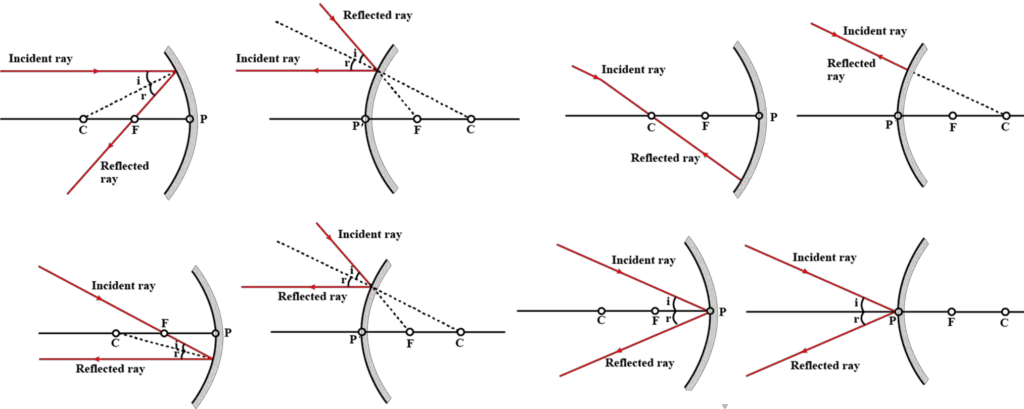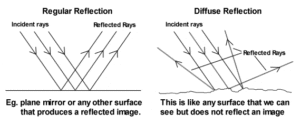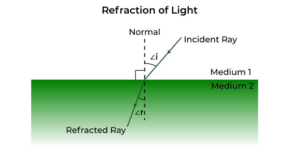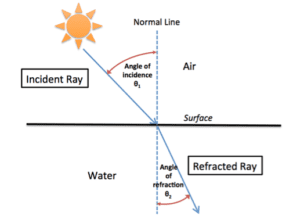This short article will teach us the rules for drawing ray diagrams for spherical mirrors. So, let’s get started…
What are spherical mirrors?
Spherical mirrors are mirrors that have a curved surface with the shape of a section of a sphere. They are commonly used in optical systems and devices, such as telescopes, microscopes, and reflective telescopic sights. Spherical mirrors can be broadly classified into two types:
Concave Mirrors

- A concave mirror curves inward, with the reflecting surface on the inner side of the curved surface.
- The center of curvature (C) of a concave mirror is located in front of the mirror, on the same side as the incoming light.
- The focal point (F) is located in front of the mirror, on the same side as the incoming light, at half the distance between the mirror and the center of curvature.
- Concave mirrors can form both real and virtual images depending on the position of the object relative to the focal point.
- Inverted images formed by concave mirrors can be projected onto a screen.
- Virtual images formed by concave mirrors are upright and cannot be projected onto a screen.
Read More:
- Derive relation between focal length and radius of curvature
- Cartesian sign convention for spherical mirrors
- Laws of Reflection of Light class 12
Convex Mirrors

- A convex mirror curves outward, with the reflecting surface on the outer side of the curved surface.
- The center of curvature (C) of a convex mirror is located behind the mirror, on the opposite side of the incoming light.
- The focal point (F) is located behind the mirror, on the opposite side of the incoming light, at half the distance between the mirror and the center of curvature.
- Convex mirrors always form virtual images.
- The virtual images formed by convex mirrors are upright, diminished, and appear to be located behind the mirror.
Spherical mirrors exhibit reflective properties, causing light rays to reflect off their surfaces based on the laws of reflection. The shape and curvature of the mirror determine how the light rays are reflected, leading to the formation of images. Understanding the behavior of light rays and the principles of image formation, we can draw ray diagrams for spherical mirrors.
Rules for drawing ray diagrams for spherical mirrors
When creating ray diagrams for image formation by spherical mirrors, there are some rules that should be followed.
For Concave Mirrors (Converging Mirrors)

- Any incident ray parallel to the principal axis will pass through the focal point (F) after reflection.
- Any incident ray passing through the focal point (F) will emerge parallel to the principal axis after reflection.
- Any incident ray passing through the center of curvature (C) will reflect back along the same path.
- For the ray incident at any angle to the pole, it follows the laws of reflection.
For Convex Mirrors (Diverging Mirrors)
- Any incident ray parallel to the principal axis will appear to diverge from the focal point (F) after reflection.
- Any incident ray directed towards the focal point (F) will emerge parallel to the principal axis after reflection.
- Any incident ray passing through the center of curvature (C) will reflect back along the same path.
- For the ray incident at any angle to the pole, it follows the laws of reflection.

So, these are some rules for drawing a ray diagram for spherical mirrors. By gaining the knowledge of these rules we can draw ray diagrams for various image formations.
Read More:
- Behaviour of light at the interface of two media
- Cartesian sign convention for spherical mirrors
- Optics: definition, types, and applications, class 12
- Simple microscope Class 12, Definition, Magnification, working, Parts And Uses
- Reflection of light class 12: definition and types
- Spherical mirrors: definition, types, and terminologies
Stay tuned with Laws Of Nature for more useful and interesting content.








